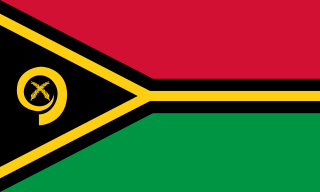
Vanuatu, officially the Republic of Vanuatu, is an island country in Melanesia, located in the South Pacific Ocean. The archipelago, which is of volcanic origin, is 1,750 km (1,090 mi) east of northern Australia, 540 km (340 mi) northeast of New Caledonia, east of New Guinea, southeast of Solomon Islands, and west of Fiji.
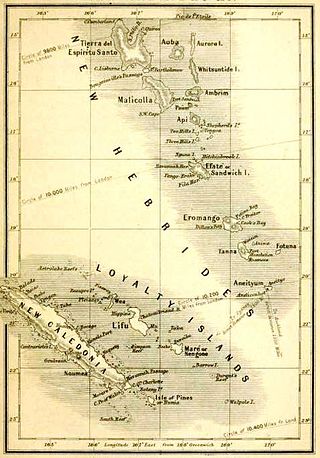
The history of Vanuatu spans over 3,200 years.
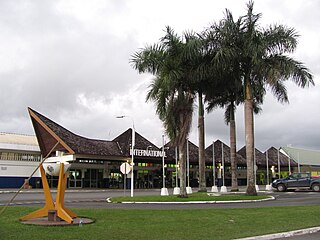
Bauerfield International Airport is an airport located in Port Vila, Vanuatu. The airport is relatively small in size, but its runway has the capability and length to accept jets up to the Airbus A330. It serves as the hub for Vanuatu's flag carrier airline, Air Vanuatu.

New Hebrides, officially the New Hebrides Condominium and named after the Hebrides Scottish archipelago, was the colonial name for the island group in the South Pacific Ocean that is now Vanuatu. Native people had inhabited the islands for three thousand years before the first Europeans arrived in 1606 from a Spanish expedition led by Portuguese navigator Pedro Fernandes de Queirós. The islands were named by Captain James Cook in 1774 and subsequently colonised by both the British and the French.

Espiritu Santo is the largest island in the nation of Vanuatu, with an area of 3,955.5 km2 (1,527.2 sq mi) and a population of around 40,000 according to the 2009 census.

John Frum is a mythical figure associated with cargo cults on the island of Tanna in Vanuatu. He is often depicted as an American World War II serviceman who will bring wealth and prosperity to the people if they follow him. Quoting David Attenborough's report of an encounter: "'E look like you. 'E got white face. 'E tall man. 'E live 'long South America."

USS Kitty Hawk (APV-1/AKV-1), formerly SS Seatrain New York, was a cargo ship that was converted into an aircraft transport during World War II.

USS Adhara (AK-71) was a Crater-class cargo ship in the service of the US Navy in the Pacific theater in World War II. Named after the star Adhara in the constellation Canis Major, it was the only ship of the Navy to bear this name.
Port Havannah is a port village on Efate Island in Vanuatu.

Ni-Vanuatu is a large group of closely related Melanesian ethnic groups native to the island country of Vanuatu. As such, Ni-Vanuatu are a mixed ethnolinguistic group with a shared ethnogenesis that speak a multitude of languages.
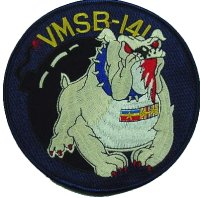
Marine Attack Squadron 141 (VMA-141) was a reserve fighter squadron in the United States Marine Corps. The squadron fought as part of the Cactus Air Force during the Battle of Guadalcanal in World War II and they also saw service during the Korean War. While with the reserves, they operated out of the San Francisco Bay Area until their deactivation on 1 September 1969.

Santo International Airport is an airport in Luganville on Espiritu Santo in Vanuatu. The airport used to be called Santo-Pekoa International airport until it was renamed in the Vanuatu AIPV amendment released on 16 June 2021. Airports Vanuatu Limited provides aviation services for the airport.

When World War II broke out the United States Naval Construction Battalions (Seabees) did not exist. The logistics of a two theater war were daunting to conceive. Rear Admiral Moreell completely understood the issues. What needed to be done was build staging bases to take the war to the enemy, across both oceans, and create the construction force to do the work. Naval Construction Battalions were first conceived at Bureau of Yards and Docks (BuDocks) in the 1930s. The onset of hostilities clarified to Radm. Moreell the need for developing advance bases to project American power. The solution: tap the vast pool of skilled labor in the U.S. Put it in uniform to build anything, anywhere under any conditions and get the Marine Corps to train it. The first volunteers came skilled. To obtain these tradesmen, military age was waived to age 50. It was later found that several past 60 had managed to get in. Men were given advanced rank/pay based upon experience making the Seabees the highest paid group in the U.S. military. The first 60 battalions had an average age of 37.
USS Advent (AM-83) was an Adroit-class minesweeper of the United States Navy. The ship was laid down on 18 August 1941 at Portland, Oregon, by the Commercial Iron Works; launched on 12 March 1942; and commissioned on 19 August 1942.
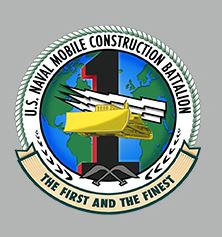
Naval Mobile Construction Battalion 1, is a United States Navy Seabee battalion. NMCB ONE, the original "Pioneers", has a long, proud and distinguished history as the very first Naval Construction Battalion of the service that would become known as the Seabees.
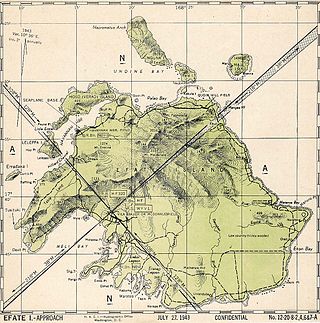
Quoin Hill Airfield was an airfield in North Efate, in Vanuatu. The airfield was used during World War II but is no longer usable as an airstrip.

Turtle Bay Airfield or Fighter Field #1 is a former World War II airfield on the island of Espiritu Santo in the New Hebrides Islands at the Espiritu Santo Naval Base.

Luganville Seaplane Base is a former World War II seaplane base in the Segond Channel between the islands of Espiritu Santo and Aore Island in the New Hebrides Islands at the Espiritu Santo Naval Base.
The 4th Antiaircraft Artillery Battalion was a United States Marine Corps antiaircraft unit that served during World War II. Formed in 1940 as the 4th Defense Battalion, its original mission was providing air and coastal defense of advanced naval bases. It was one of first five defense battalions deployed in support of the color-coded war plans that called for the defense of Hawaii and other outlying United States possessions in the Pacific Ocean. These five battalions were nicknamed the "Rainbow Five." During the war the battalion took part in combat operations during the attack on Pearl Harbor and at Vella Lavella. The battalion was decommissioned on 9 June 1945 before the end of the war.

Naval Advance Base Espiritu Santo or Naval Base Espiritu Santo, most often just called Espiritu Santo, was a major advance Naval base that the U.S. Navy Seabees built during World War II to support the Allied effort in the Pacific. The base was located on the island of Espiritu Santo in the New Hebrides, now Vanuatu, in the South Pacific. The base also supported the U.S. Army and Army Air Corps, U.S. Coast Guard, and US Marine Corps. It was the first large advance base built in the Pacific. By the end of the war it had become the second-largest base in the theater. To keep ships tactically available there was a demand for bases that could repair and resupply the fleet at advance locations, rather than return them to the United States. Prior to December 7th, Pearl Harbor was the U.S. fleet's largest advance base in the Pacific. Espiritu became capable of all aspects necessary to support the Fleet's operations from fleet logistics in fuel, food, and ammunition, to transport embarkation for combat operations or returning to the continental United States. The ship repair facilities and drydocks were capable of attending to most damage and routine maintenance. Had it not existed, ships would have had to return to Pearl Harbor, Brisbane, or Sydney for major repairs and resupply. The base became a major R and R destination for the fleet.

















